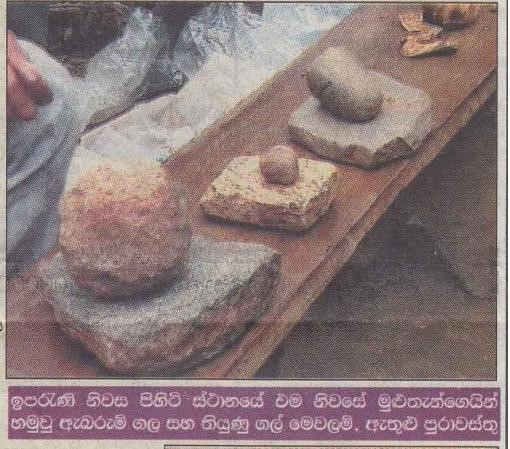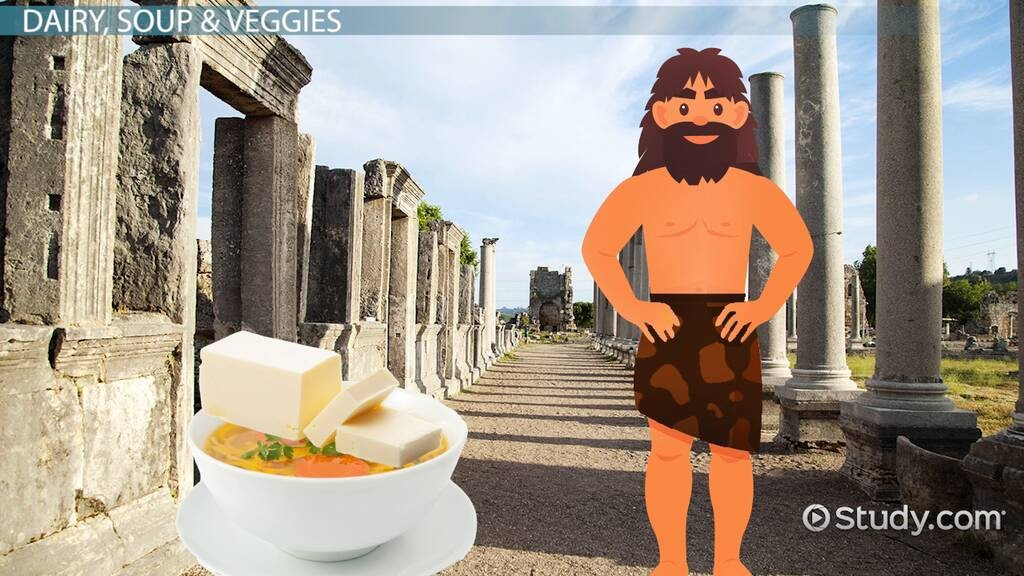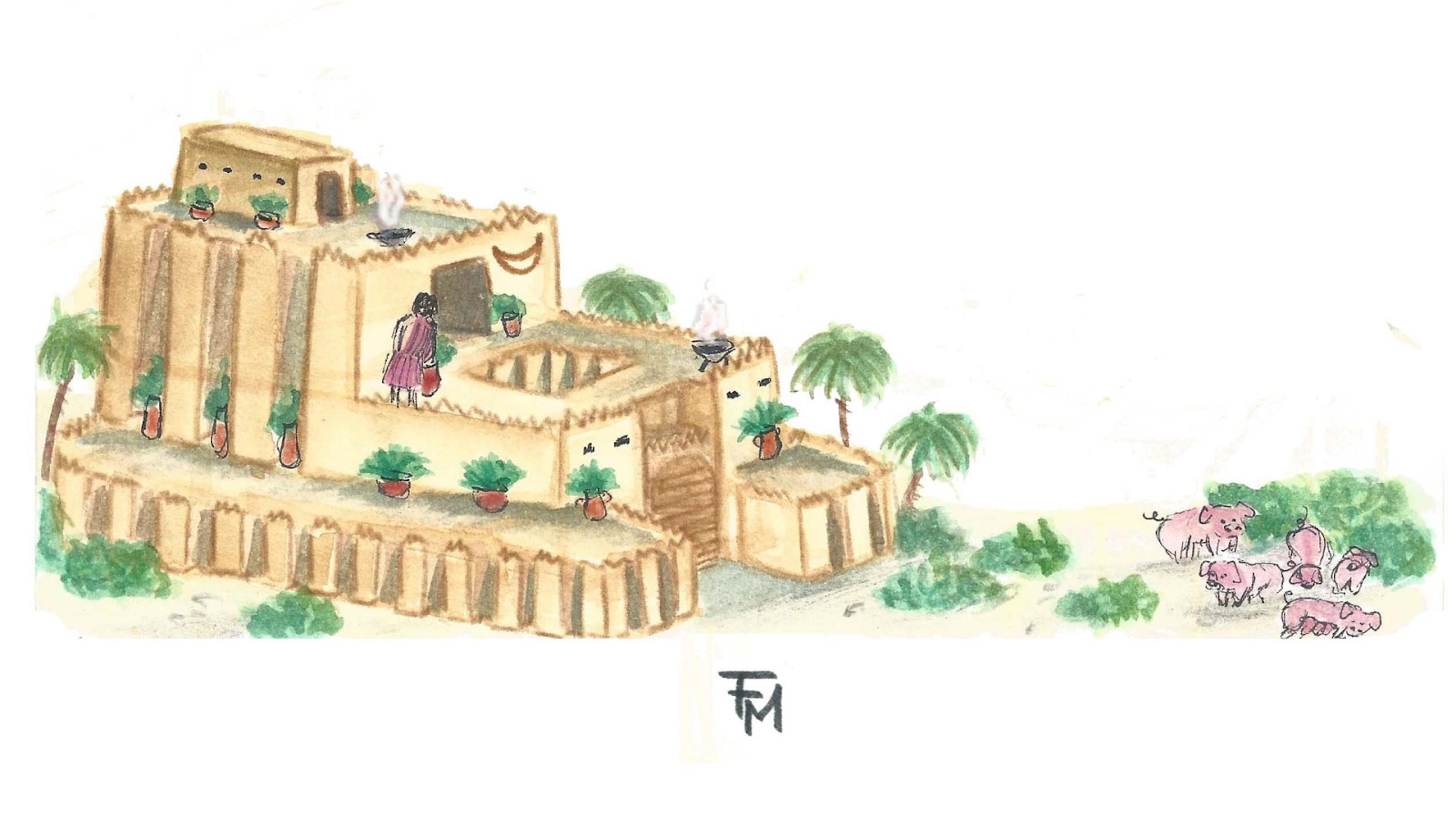"FOOD HABITS OF TAMILS" PART / "பண்டைய சுமேரியரின் உணவு பழக்கங்கள் தொடர்கிறது"" / "Food Habits Of Ancient Sumer continuing"" [தமிழிலும் ஆங்கிலத்திலும் / In English and Tamil]
மெசொப்பொத்தேமியாவில் இருந்து ஒரு சில சமையல் செய்முறை மட்டுமே இன்று தப்பி பிழைத்துள்ளன. முக்கியமாக 7" X 9 .5 " அளவைக் கொண்ட, மூன்று பெரிய பாபிலோனிய களிமண் பலகையில் - கியூனிபார்ம் எழுத்துக்களில் - அவை ஓரத்தில் சிறிது சிதைவுண்டு இருந்தாலும் கூட - சுமார் 35 உணவு வகைகள் குறிப்பிடப்பட்டுள்ளது. இவை, அமெரிக்காவில் உள்ள யேல் பலகலைக்கழகத்தில் [Yale university] வைக்கப்பட்டுள்ளன. அவை யேல் பலகலைக்கழக பேராசிரியர்களால் கண்டு பிடிக்கப்பட்டதால், அவை யேல் சமையல் பலகைகள் என்றே அழைக்கப் படுகின்றன. இதுவே உலகின் மிகப் பழமையான சமையல் புத்தகம் ஆகும். என்றாலும் இந்த சிக்கலான, எளிதற்ற கியூனிபார்ம் எழுத்துக்கள் பாமர சுமேரியர்களால் அன்று வாசித்து இருக்க முடியாது. இவை, கியூனிபார்மை பற்றி சிறப்பாக எழுத வாசிக்க ஆண்டு கணக்காக படித்த எழுத்தர்களால் [scribes] மட்டுமே விளங்கிக் கொள்ளக் கூடியவையாக காணப் படுகின்றன. ஆகவே இந்த சமையல் குறிப்பு அல்லது நூல், சாதாரண சமையற்காரர் அல்லது தலைமைச் சமையற்காரருக்கு எழுதப்பட்ட வையாக அதிகமாக இருக்க முடியாது. எனவே, இது அன்று, 4000 ஆண்டுகளுக்கு முன்பு, நடைபெற்ற சமையலைப் பற்றிய ஒரு ஆவணமாக அல்லது தொகுப்பாக இருக்கலாம். இந்த சமையல் குறிப்புகள் மிகவும் விரிவாகவும் ஆனால், அபூர்வமான, அரிதான கூட்டுப் பொருள்களை கொண்டதாகவும் இருக்கிறது. ஆகவே இவை மெசொப்பொத்தேமியாவின் அரண்மனைக்கான சிறப்பு உணவாக அல்லது மேல் தட்டு வர்க்கத்தினருக்கான அல்லது கோயிலின் மடைப்பள்ளியில் தயாரிக்கும் மத பிரசாதத் திற்க்கான, சிறப்பு [விசேஷ] கால, சிறப்பு சமையல்களாக இருக்கலாம் என ஊகிக்கப் படுகிறது.
என்றாலும் யேல் சமையல் பலகைகளில் உள்ள சமையல் குறிப்புகளை இன்று முற்றாக புரிந்து
கொள்வதில் மிகவும் சிரமம் காணப் படுகிறது. காரணம் இந்த களிமண் பலகை உடைந்த, சிதைந்த
நிலையில் உள்ளதும், இதிலுள்ள வார்த்தைகள், மொழி நமக்கு புரியாததாக, பரிட்சயம் அற்றதாக
உள்ளதும், மேலும் அந்தக் கால மக்கள் சமையல் செய்த கூட்டு பொருட்கள் பற்றி நாம் முழுமையாக
அறியாது இருப்பதும் ஆகும். அது மட்டும் அல்ல, இந்த சமையல் குறிப்பில், சமைக்கும் நேரம்,
சமையலுக்குத் தேவையான பொருட்களின் அளவு போன்றவை காணப்படவில்லை. ஆகவே இது ஒரு கை தேர்ந்த
சமையல்காரருக்காக தயாரிக்கப் பட்டது போல் தோன்றுகிறது. என்றாலும் - உயிரியல், விஞ்ஞானம்,
தொல்பொருள், இலக்கியம் சார்ந்த ஒரு ஊகத்தின் அடிப்படையில் - அங்கு குறிக்கப்பட்ட
கூட்டு பொருள்கள், இன்று ஓரளவு அடையாளம் காணப்பட்டுள்ளன. அசிரியன்கள் [Assyrian] பற்றி
ஆராயும் பிரெஞ்சு நாட்டின் ஜீன் போட்டீரோ (Jean Bottero), என்ற ஆராய்ச்சியாளர், மார்ச்
1985 ல் அருங்காட்சியக பத்திரிகை ஒன்றில் உலக மக்களுக்கு பேட்டி அளிக்கும் போது, இதிலுள்ள
தகவல்கள் நம்மை வியப்பில் ஆழ்த்தி மயக்க மடையச் செய்கின்றன என்றும், சமையல் குறிப்பில்
அவர்களின் செல்வ வளம், துல்லியமாய் சமைத்தல், நெளிவு சுளிவுகள், ஆடம்பரமான நுணுக்கங்கள்
போன்றவற்றைத் தெள்ளத் தெளிவாகக் குறிப்பிடப்பட்டுள்ளன என்றும், அந்த ஆதிகாலத்திலேயே
இத்தனை தகவல்கள் சொல்லப்பட்டிருப்பது மிகவும் ஆச்சரியமான ஒன்று என்றும் குறிப்பிட்டுள்ளார்.
இப்போது, இன்றைய நவீன உலகில், பெண்ணோ ஆணோ பொதுவாக சமையல் புத்தகம் இல்லாமல் சமைப்பதில்லை. ஏராளமான சமையல் புத்தகங்கள், சஞ்சிகைகள் பரந்த அளவில் காணப்படுகின்றன. ஆனால் எமது பாட்டியை, பாட்டனை கேட்டால், அவர்கள் எள்ளி நகையாடுகிறார்கள்? அப்படி என்றால், உண்மையாகவே, சமையல் புத்தகம், சமையல் குறிப்பு முன்பெல்லாம் எழுதப்படுவதில்லையா? அதெல்லாம் இல்லை. கிட்டத்தட்ட நாலாயிரம் ஆண்டுகளுக்கு முன்பே, இந்த நாளாந்த சமையல்கள் பதிவு செய்யப்பட்டிருக்கிறது. மேலும் யேல் சமையல் குறிப்புகளில் ஒன்று மட்டும் தெளிவாகவும், பொதுவானதாகவும் உள்ளது. அதாவது எல்லா உணவிலும் கோழி, மரக்கறிகள், தானியம் மற்றும் தண்ணீர் என்பவை பயன்படுத்தப் பட்டுள்ளது. இதற்கு முன்பு பொதுவாக, நேரடியாய் நெருப்பில் போட்டு அல்லது சுட்டு அல்லது எதாவது பாத்திரம் மாதிரி ஒன்றில் வதக்கி அல்லது வறுத்து அல்லது தீத் தணலில் புரட்டி புரட்டி வாட்டி தமது உணவுகளை தயாரித்தனர். அதன் வளர்ச்சியாகத் தான், இந்த நீரில் போட்டு சமைப்பது நாளடைவில் பரிணமித்து இருக்கலாம். உதாரணமாக கி மு 1750 ஆண்டை சேர்ந்தது என கருதப்படும், முதலாவது யேல் சமையல் பலகை, YBC 4644, 25 சமையல் செய்முறைகளை கொண்டுள்ளது. இவை 21 புலால் துவட்டலும் [மெதுவாக வேகவைத்த சமையல் / stews] 4 காய்கறி துவட்டலும் ஆகும். இந்த சமையல் குறிப்பு கலக்கும் அல்லது சேர்க்கும் மூலப் பொருட்களின் பட்டியலையும் அது எந்த வரிசையில் சேர்க்கப்பட வேண்டும் என்பதையும் தருகிறது. ஆனால் எவ்வளவு, எவ்வளவு நேரம் போன்ற தரவுகள் அங்கு காணப்படவில்லை. இரண்டாவது யேல் சமையல் பலகை, YBC 8958 ஆகும். இது 7 சமையல் குறிப்புகளை விரிவாகத் தருகிறது. சமையல் பலகை பல இடங்களில் முறிந்து காணப்படுவதுடன் இரண்டாவது சமையலின் பெயர் காணப் படவில்லை. ஆனால் இது ஒரு சின்னப் பறவை ஒன்றில் சமைத்த உணவு. அதிகமாக அந்த பறவை கௌதாரியாக [partridges / a short-tailed game bird with mainly brown plumage, found chiefly in Europe and Asia] இருக்கலாம் என அறிஞர்களால் ஊகிக்கப்படுகிறது.
{{கிருஸ்துக்கு முன்னான, சிங்கள இனம் என ஒன்று தோன்றாதா இலங்கையை நாம் கருத்தில்
கொள்ளும் பொழுது, டாக்டர் தேரணியகல [Deraniyagala] அவர்களால் பண்டைய இலங்கை வேட்டைக்காரர்கள்
மற்றும் உணவு சேகரிப்பாளர்கள் எப்படி உணவு தயாரித்தார்கள் என்பதை ஒரு படம் மூலம் எடுத்துக்
காட்டியது ஒரு நல்ல சான்றாக உள்ளது [பலாங்கொடை மனிதன் / படம் - 01]. அதே போல, தொல்பொருளியல்
பிரிவின் பேராசிரியர் ராஜ் சோமதேவ [Dr Raj Somadeva], தன் ஆய்வின் பொழுது பண்டைய ஒரு
வீட்டின் சமையலறை ஒன்றை உடவளவை குன்றில் உள்ள, ரஞ்சமடம [Ranchamadama in Uda
Walawe hillock] என்ற இடத்தில் கண்டு பிடித்தார். அங்கு சமையலில் இருந்து கரி எடுக்கப்பட்டு C 14 யை ஆராய்ந்த பொழுது, இது கி மு 1000 ஆண்டு
என கணக்கிடப் பட்டது. அந்த பண்டைய சமையல் அறையில், அந்த வீட்டு பெண், உணவு தயாரிக்க
பாவித்த அரைத்தல், கலத்தல் போன்றவைக்கான [Grinding, mixing and blending etc] பாத்திரங்கள்
அல்லது கருவிகள் அவர் வெளியிட்டுள்ளார் [ படம் - 02] இவைகள் எல்லாம் இலங்கையின் பண்டைய
சமையல் முறை பற்றி அறிய உதவியாக உள்ளது. அது மட்டும் அல்ல, அந்த அகழ்வின் பொழுது, மான்
மற்றும் கடமான்களின் [Deer and Moose] எச்சமும்
கண்டு பிடிக்கப் பட்டது. எழுத்துருவில், பண்டைய காலத்தில் பதியப்பட்ட இலங்கை உணவு பற்றிய செய்தி ஒன்றும் மகாவம்சத்தில் காணப்படுகிறது.
மகாவம்சம், அத்தியாயம் 7. 21 இல் "இவர்கள் பசித்து இருக்கிறார்கள் என்று அவன்
[விஜயன்] சொன்னதும், தன்னால் விழுங்கப்பட்ட வர்த்தகர்களின் கப்பலில் இருந்த அரிசியையும்
இதர பொருட்களையும் அவள் [குவேனி] அவர்களுக்கு காட்டினாள் என்கிறது. அதை தொடர்ந்து அவர்கள்
சுவையூட்டும் பொருள்களுடன் சோறு ஆக்கி எல்லோரும் உட்க்கொண்டார்கள். பண்டைய கல்வெட்டுகளில்
இருந்து அந்த சுவையூட்டும் பொருள்கள் அதிகமாக, மிளகு மற்றும் உப்பை விட, மேலும் மஞ்சள், இலவங்கப்பட்டை [கறுவா], இஞ்சி
போன்றவையும் அடங்கும் எனத் தெரிய வருகிறது.}}
நன்றி
[கந்தையா தில்லைவிநாயகலிங்கம்,
அத்தியடி, யாழ்ப்பாணம்]
பகுதி : 13 தொடரும்…….
Theebam.com: "தமிழரின் உணவு பழக்கங்கள்" பகுதி: 13:
Theebam.com: "தமிழரின் உணவு பழக்கங்கள்"பகுதி: 01:
"FOOD HABITS OF TAMILS" PART: 12 "
Food Habits Of Ancient Sumer continuing
Out of the cuisines of ancient Mesopotamia, the oldest known written recipes, which are known as Recipe tablets from the Yale Babylonian Collection, Only very few recipes are survived today. They are 35 recipes incised on three clay tablets that form part of the Yale Babylonian collection, Now held at Yale university, containing recipes in Akkadian, contain a recipe for meat stew, and actually a team replicated the recipe at an exhibition at NYU in 2018, Probably originating from southern Mesopotamia. These tablets created in1650 to 1750 BCE, plus a additional recipes written much later. The cuneiform writing system was complex and generally only scribes who had studied for years could read and write, such as the selected government bureaucrats, priests, and merchants. so it is unlikely that the cookbooks were meant for the ordinary cook or chef. Instead, they were written to document the current practices of culinary art or Recipes to religion. In Mesopotamia, Caring for the gods was an important government obligation and food was offered daily by priestly bureaucrats acting on behalf of the king, The recipes are elaborate and often call for rare ingredients. Therefore, We may assume that they represent Mesopotamian haute cuisine meant for the royal palace or formal "Culinary Liturgy" for religious offerings. Further, We can assumed that, They simply had reasons to write down their recipes, as these recipes - as we pointed out - were intended for use in a religious context and to maintain uniformity across all temples. They are all for versions of a meat-in-sauce dish which would be served to a god in his temple, accompanied by bread (probably mixed barley and wheat) and date cakes, etc. The god (probably Marduk in this instance, as he was the city god of Babylon) would eat behind closed curtains. Leftovers would go to the king. It was only in 1995 that Bottero published a full translation and commentary; and discussion will no doubt continue. It does seem clear, however, that these fragments of evidence should not be interpreted as reflecting the food of the common people of the time.There are also other several sources you can use to find information on the foods, agricultural practices, and dining customs of ancient world to understand deeply and clearly.
These Yale tablets are damaged and contain words that scholars have been unable to translate. They are difficult guides because so many parts are missing. Nonetheless, They are the single best evidence of how dishes dating back to about 4000 years might have been prepared. Most of the recipes were now by guesses based on scientific, archaeological, biological and other literary evidences. The present state of the research tells only little about the sauces, seasonings and condiments used in Mesopotamian cookery. One thing is sure, that without writing, recipes cannot survive. Yet the absence of written recipes does not rule out an interest in gastronomic matters of the existence of sophisticated culinary techniques. For example, the ancient Egyptians apparently felt no need to write down their recipes, yet we find instructive traces of their cooking methods in tombs dating from as early as the fourth millennium.
From stone tablets to digital ones, recipes have always been an essential part of cooking. Cookbooks may be general, or may specialize in a particular cuisine or category of food. may be written by individual authors, who may be chefs, cooking teachers, or other food writers; they may be written by collectives; or they may be anonymous. A question I’ve asked myself many times is: ‘how will technology impact cookbooks?’ Will they become obsolete, or will there always be space for food-stained volumes of recipes stacked on a kitchen shelf? However, Ask any food lover what books lie on their bedside table, and you’re almost guaranteed that at least one will be a cookbook. Yes, Mesopotamian priest or chief cook probably kept all these clay tablets on his bedside which demonstrate Recipes for meat and vegetarian dishes, and a few stews. The first tablet YBC 4644, includes 25 recipes for stews, 21 are meat stews and 4 are vegetable stews. The recipes list the ingredients and the order in which they should be added, but does not give measures or cooking time - they were clearly meant only for experienced chefs. the second tablet, YBC 8958, has seven recipes which are very detailed. The text is broken in several places and the name of the second recipe is missing, but it is a dish with small birds, maybe partridges.
{{When we consider pre Christian Srilanka's food habits, Before the evaluation of Sinhala race from the combination of Arians and Dravidians [Tamils], we find a sketch of how the ancient hunters and food gatherers cooked their meals by Dr Deraniyagala [Balangoda Man / Photo - 01 ] and Also Dr Raj Somadeva discovered an ancient House with a kitchen at Ranchamadama in Uda Walawe hillock, the charcoal off the cooking was C 14 dated to over 1000 BC. The utensils used by the lady of the house for preparation [Grinding, mixing and blending etc] of food was published by him [Photo - 02] Remain of Deer and Moose was also found during the excavations, which included fired pottery and beads, perhaps worn by the lady of the house. Small quartz cutters and scrapers were also found, these were used for preparation and eating of food such as meat and fruits etc. The earliest written mention of food was in the Mahavamsa Chapter 7.21, the circumstances under which the first meal taken by the Vijaya [500 BC] and his men as described: "When he [Vijaya] said, ‘These men are hungry,’ she [Kuveni] showed them rice and other (food) and goods of every kind that had been in the ships of those traders whom she had devoured. (VIJAYA’s) men prepared the rice and the condiments, and when they had first set them before the prince they all ate of them" The condiments available to flavour food other than pepper and salt are such as Turmeric, Cinnamon, Ginger etc. as mentioned in inscriptions and ancient text.}}
Thanks
[Kandiah Thillaivinayagalingam, Athiady, Jaffna]
PART : 13 WILL FOLLOW…

















0 comments:
Post a Comment